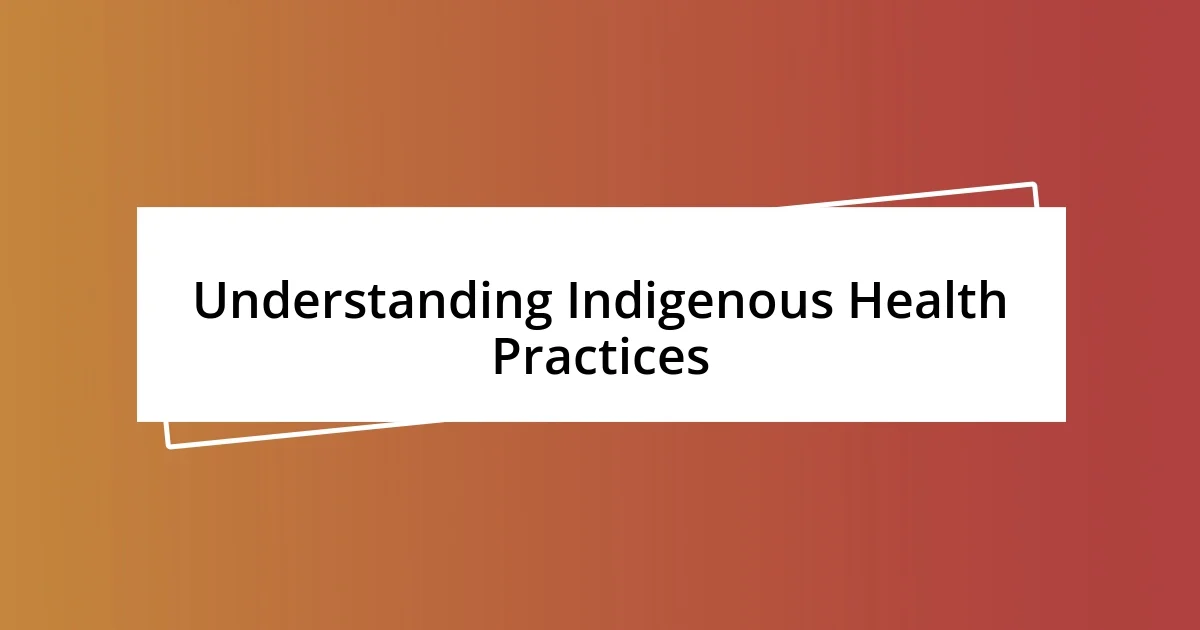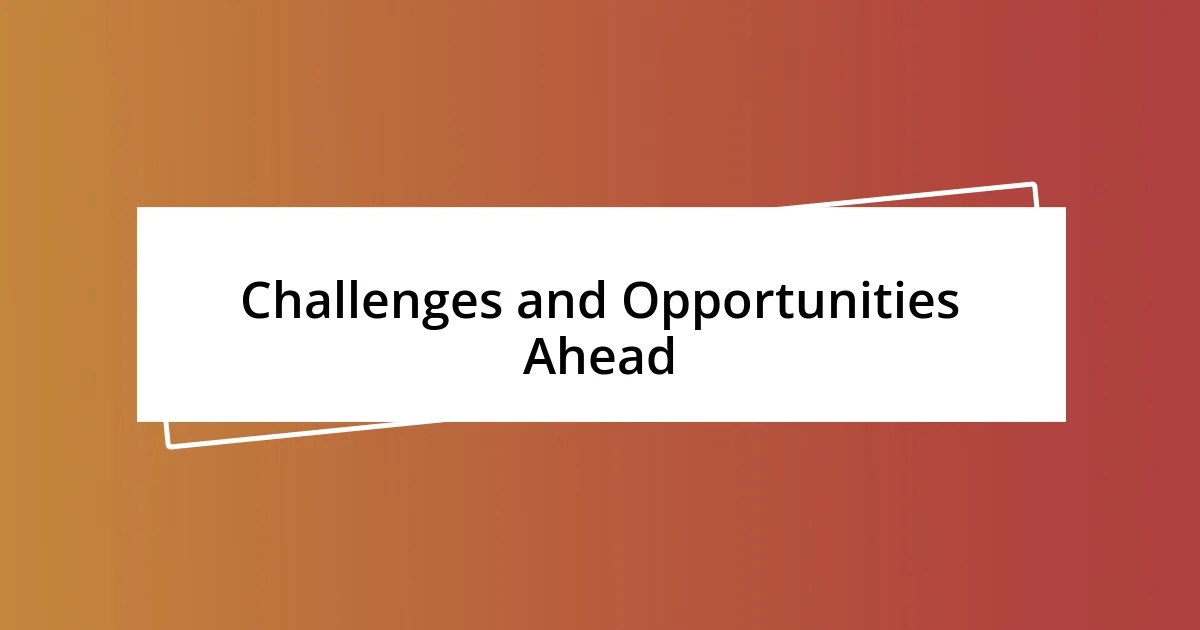Key takeaways:
- Indigenous health practices emphasize a holistic approach, intertwining physical, emotional, and spiritual well-being, and reflecting a deep connection to the land and cultural identity.
- The historical context reveals the impact of colonialism and systemic neglect on Indigenous health, while revival movements empower communities by blending traditional and modern healing methods.
- Integrating Indigenous practices with modern healthcare offers a more personalized care model, yet challenges such as cultural misunderstandings highlight the need for collaboration and dialogue in healthcare settings.

Understanding Indigenous Health Practices
Indigenous health practices are deeply rooted in ancestral knowledge and the connection between people, land, and spirit. I remember walking through a lush forest with an Indigenous elder who spoke about the healing properties of local plants. It was a revelation: each plant holds its own story, and understanding these stories can lead to profound healing experiences.
These practices often emphasize a holistic approach, considering physical, emotional, and spiritual health as interconnected aspects of well-being. Have you ever thought about how your environment influences your health? For Indigenous communities, the land is not just a resource but a living entity integral to their identity and health. This symbiotic relationship fosters a deep respect for nature that informs their healing traditions.
Moreover, traditional healing methods frequently coexist alongside modern medical practices, creating a unique blend of approaches. I’ve witnessed how this integration offers a more comprehensive care model that respects cultural beliefs while providing necessary medical interventions. It prompts me to ask: how can we better appreciate and learn from these diverse health perspectives in our own communities?

Historical Context of Indigenous Health
As I delve into the historical context of Indigenous health, it’s clear that these practices emerged long before transcontinental influences reshaped health paradigms. The legacy of colonialism had significant implications for Indigenous peoples’ health, often stripping away their traditional practices and imposing unfamiliar medical systems. I recall a conversation I had with a young Indigenous woman who reflected on how her grandmother’s healing rituals were nearly erased during these times, highlighting a painful yet resilient thread in their cultural narrative.
In many regions, Indigenous communities faced systemic neglect, leading to disparities in health outcomes. I once visited a reservation where access to healthcare services was limited, yet the community thrived through its traditional practices. The elders shared with me how these customs served as not just medical treatments but as cultural touchstones that foster community resilience. It was a poignant reminder of the strength found in cultural identity, especially when faced with adversity.
Moreover, understanding this historical context is pivotal for acknowledging the ongoing challenges that Indigenous health practices confront today. I think about the modern efforts to revive these practices, blending them with contemporary health strategies. In my view, this resurgence is not only about healing the body but also about healing the collective spirit of Indigenous communities, reaffirming their identity against a backdrop of historical trauma.
| Historical Event | Impact on Indigenous Health |
|---|---|
| Colonialism | Disruption of traditional practices and imposition of Western medicine. |
| Systemic Neglect | Worsening health disparities due to lack of resources and access to care. |
| Revival Movements | Empowerment of communities through the blending of traditional and modern practices. |

Cultural Significance in Health Practices
The cultural significance in Indigenous health practices cannot be overstated. I recall a gathering where an elder shared stories about the role of ritual in healing. As she spoke, I felt the weight of tradition—how these rituals not only treat ailments but also reinforce community ties and identity. It struck me that healing goes beyond the physical; it involves the collective memory and cultural heritage of the people.
- Traditional ceremonies often integrate specific songs, dances, and prayers, which serve as a medium for healing.
- Elders are revered not just for their knowledge but as custodians of community stories that embody health practices.
- The use of culturally significant symbols during healing processes fosters a sense of belonging and continuity.
Understanding this deeper layer helps me appreciate that for many Indigenous peoples, health is inseparable from their cultural narrative. The intertwining of personal history with health practices speaks to the core of what it means to be a community.

Holistic Approaches to Wellbeing
Holistic approaches to wellbeing are deeply rooted in Indigenous health practices, emphasizing the interconnectedness of body, mind, and spirit. I often think about how during a wellness retreat in a Native American community, we participated in a sweat lodge ceremony. It was striking to feel the warmth and connection to the earth, which added a layer of physical cleansing that was so much more than merely sweating out toxins. In that moment, I realized how integral this practice was not just to individual health, but to forging bonds within the community.
I’ve also seen how traditional healing involves a blend of physical treatment with emotional and spiritual support. I remember attending a community gathering where healers used storytelling as a way to address trauma and promote healing. Listening to those tales, I could sense a palpable shift in the room; there was a mutual acknowledgment of pain, which in itself was a step towards collective healing. Isn’t it fascinating how sharing experiences can mend not just individuals but entire communities?
Moreover, these holistic methods often include the use of natural medicines drawn from the land, which fosters a profound respect for the environment. Reflecting on my own experiences in nature, I often turn to herbal remedies I’ve learned about from Indigenous friends, appreciating their wisdom about plants not only as medicine but as vital components of wellbeing. How can we overlook the healing power of nature when it’s been a cornerstone of Indigenous practices for centuries? The deep-rooted understanding that our health is intrinsically tied to our environment is something I believe we could all gain from adopting in our modern lives.

Traditional Healing Methods Described
Traditional healing methods often encompass a diverse array of practices, reflecting the unique cultural beliefs and historical contexts of Indigenous communities. In one memorable experience, I attended a healing circle where a community elder employed the power of fire to purify and promote wellness. The rhythmic crackle of the flames and the soft murmurs of prayers created an atmosphere that felt sacred. I could feel the energy shifting, as if each spark lifted away not just individual burdens, but collective worries. It made me ponder how something as elemental as fire can serve as a conduit for transformation and healing.
Another fascinating aspect of traditional healing is the role of plants and natural resources. I remember walking through a forest with a local healer, who shared his knowledge about specific herbs used for medicinal purposes. He picked a handful of wild sage, explaining its cleansing properties and how it’s used in ceremonies. In that moment, I was struck by a profound sense of respect for nature’s wisdom. Isn’t it incredible how Indigenous practices often remind us that our environment holds answers to our health? The connection between human health and the ecosystem not only deepens my understanding of healing but also emphasizes the importance of sustainability.
Furthermore, many traditional healing methods involve community participation, reinforcing social bonds and collective responsibilities. I recall an instance where the community came together for a powwow that integrated dance, music, and storytelling—all with the purpose of healing not just individuals, but the entire community. As I joined in, I felt a sense of belonging that transcended mere physical health. Isn’t it interesting how healing can also be about nurturing relationships and fostering unity? This collective embrace of wellness underlines the importance of community in Indigenous health practices, highlighting that true healing happens together.

Integration with Modern Healthcare
Integrating Indigenous health practices with modern healthcare can create a more comprehensive approach to wellness. I remember a time when I visited a health clinic that involved Indigenous healers alongside conventional doctors. The way they collaborated was inspiring; patients were encouraged to explore both traditional and modern treatments. Doesn’t it make sense that blending these perspectives can lead to a more personalized, effective care strategy?
I’ve witnessed the impact of this integration firsthand. During a health workshop, I saw how patients benefited from having access to herbal remedies right alongside their prescribed medications. One participant shared how incorporating traditional teas had alleviated her anxiety. It struck me that bridging the gap between these worlds can empower patients, providing options that resonate with their cultural backgrounds. Isn’t it fascinating to think about how choice can enhance our healing journeys?
Moreover, the respect for holistic wellness in Indigenous practices can serve as a guide for modern healthcare. I learned about a health initiative that included mindfulness and storytelling sessions as part of their patient care plan. Participants often left feeling more connected, not just to their communities but to themselves. How incredible is it that stories—rooted in culture—can be pivotal in not just healing, but fostering a sense of belonging? Emphasizing this kind of integration might just reshape our understanding of health and wellness for the better.

Challenges and Opportunities Ahead
When considering the challenges ahead, it’s evident that the intersection of Indigenous health practices and modern healthcare isn’t always smooth. I remember a conversation with a healthcare professional who expressed concern over cultural misunderstandings. It struck me how important it is to foster dialogue and respect for these rich traditions within clinical settings. How can we bridge these gaps when there is often a lack of awareness about Indigenous approaches?
The opportunities, however, lie within these challenges. During a community forum I attended, the participants discussed creating programs that honor both traditional practices and western medicine. I could feel the hope in the air as people brainstormed ways to ensure that young Indigenous healers could gain access to formal training. Isn’t it uplifting to think that the next generation might thrive by learning the best of both worlds?
Moreover, there’s a growing movement among healthcare systems to include Indigenous voices in policy-making. I once met a young leader passionate about advocating for her community’s health needs. She shared how engaging Indigenous perspectives in healthcare development can lead to initiatives that truly resonate with cultural values. Isn’t it exciting to imagine a future where Indigenous wisdom is not just acknowledged, but fundamentally woven into the fabric of healthcare?














